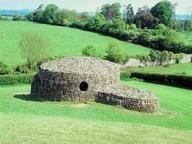Quiz Answer Key and Fun Facts
1. The Fenian Cycle is named for Demna, son of Cumhal, commonly known by the more famous name 'Finn' (fair one). Finn was a doughty warrior, and like other Irish heroes he proved his skill at arms at a very tender age. But Finn mac Cumhal (sometimes modernized as Finn mac Cool) was also famous for his erudition. Which of the following is a (partial) description of how Finn became so wise?
2. Which of the following is NOT a crucial element of the tale of how Finn met his (future) wife, Saba?
3. Finn's only son was called Oisin (eponymous with the Ossianic Cycle). What does the name Oisin mean?
4. Finn's warrior daughter bore Finn a grandson, Geena mac Luga. Finn made Geena a captain of men, but Geena proved, slothful, selfish and cruel, and the men rebelled. Finn famously corrected his grandson's ill behavior by teaching him a set of maxims. Which of the following was NOT one of the 'Maxims of the Fianna'?
5. I have already alluded to the 'Fianna,' the men of whom Finn was the leader (their name was NOT derived from Finn's). Before a warrior would be permitted to join the Fianna, he had to pass certain severe tests. Which of the following was not among the five tests of the Fianna?
6. Among Finn's greatest friends was Dermot O'Dyna of the Love Spot, the Irish Adonis. A number of the Fenian tales center on Dermot. In a tale of Dermot's childhood, Dermot's father Donn kills another child in an act the full consequences of which were not to be felt until much later in Dermot's life. Who did Donn kill by squeezing him or her to death between his knees?
7. In another tale Finn and his men are transported to land of the Faery-folk, there to help a Faery king defeat a rival in battle. Thirteen of Finn's men get there by being abducted by the king, who wore the guise of the Gilla Dacar (Hard Gillie or Difficult Servant, Difficult {Guide);} Finn and most of his men find their way to the enchanted realm by wandering through a cave. How does Dermot find his way down?
8. Which of the following is a (partial) explanation of how Finn's hair turned grey?
9. Which of the following is NOT an element of the episode leading to the death of Dermot?
10. Accounts differ, and are at best incomplete, as to the final ends of both Finn and his son Oisin -- one tradition would have it that they never died and instead are sleeping in a cave, waiting until they are needed -- so I will end the quiz with a question regarding the end of the Fianna, the warriors loyal to Finn. Who brought about the destruction of the Fianna?
Source: Author
xaosdog
This quiz was reviewed by our editing team before going online.
Any errors found in FunTrivia content are routinely corrected through our feedback system.

